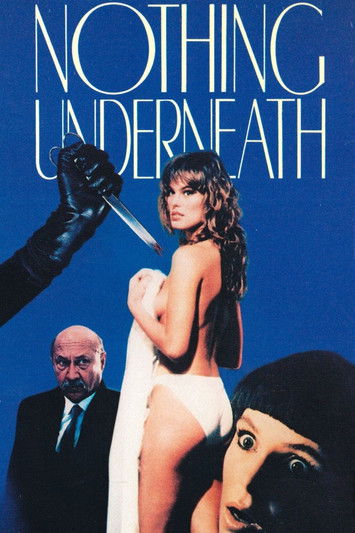For the uninitiated, giallos are (usually) Italian crime films that tend towards the lurid. Often accused of being a prototype of the slasher genre, they usually feature point-of-view cameras stalking victims with a black-gloved hands and some slicey-pokey weapon in view. They also have bloody corpses, incomprehensible plots, mysteries you cannot solve on your own because the script hides critical evidence, bizarre plot twists, and gratuitous nudity.
This year, quite a few people I follow on social media watched the new release Malignant and said “hey, what is this weird thing I just watched?” It was a giallo. If you liked Malignant because it was bonkers and weird and kind of awful movie, you like giallo. If you hated it for the same reasons, then you are going to hate giallo. Will you like Nothing Underneath? That’s a good question.

Careful, Bob. Your next words will decide if you are in the right elevator or the wrong one.
Nothing Underneath is an Italian-American giallo made well into the genre’s decline in the mid-80s. The star is American television character actor Tom Schanley as Bob Crane. Schanley had just come off a stint on the one-season Western The Yellow Rose starring Sam Elliot and Cybill Shepherd. He’d later have short runs on Dynasty and Melrose Place. His co-star is the Danish supermodel Renée Simonsen, who was all over magazine covers at the time and busy being a model for CoverGirl and Maybelline. Her face is probably familiar, even if her name isn’t. Lending his star power, if only in a secondary role, is Donald Pleasence. He plays a retiring police inspector up for one last missing persons case.
Bob and his sister Jessica, played by English model Nicola Perring, are fraternal twins who share a psychic bond. Jessica left the US for a modeling career and is on the verge of making it big. Things go poorly for her when she spurns the advances of a big-shot coke-head in a nightclub restroom, though. Bob, halfway around the world in Yellowstone National Park where he’s a park ranger, senses the danger and tries his best to get in touch with his sister. Failing that, he flies to Milan and starts trying to figure out what happened. He reports his sister’s disappearance to Inspector Danesi (Pleasence), who listens to Bob’s “psychic link” tale with clear bemusement.

I see our murderer has chosen the retro preschooler two-fisted grip for the scissors. Bold choice, might regret it when it’s time to turn the doorknob.
In another giallo — perhaps one like What Have You Done With Solange — the police would treat Bob’s wacky story with immediate suspicion. But Bob is not a suspicious character. He’s a handsome, gormless, small-town, puppy-like naif, clearly unaware that he’s talking nonsense. Danesi takes pity on him and does his best to find Jessica before his retirement date comes up.
As a giallo, Nothing Underneath ticks all the required boxes. The pokey-slicey weapon is a pair of scissors, sure, but it is both pokey and slicey. The gloves are black, the murder-cam point-of-view. But all of this seems toned down. Were they trying to adjust for American tastes? Around the time this movie came out, slasher films themselves were losing their edge, facing a backlash from several political directions. Schanley says in an interview on-disc that they’d hoped and planned for an American theatrical release, but that never happened. Nothing Underneath is an engaging story, but as giallo goes, it is pretty low key. This might make it less than you hoped, but it might also make it an excellent introduction for the giallo-curious.
Donald Pleasence is absolutely delightful in the film, however. Schanley remembers Pleasence always trying to find the humor in his character, something he did well. There’s a Jessica Fletcher quality to him. My favorite scene takes place in a Milanese Wendy’s, Danesi heaping iceberg lettuce from the Superbar onto his plate while discussing Jessica’s disappearance with Bob. Bob is eating a burger and fries.
“I never liked red sauces,” says Danesi, eyeing the ketchup. “They remind me too much of blood.” I had to stop the movie and collect myself a bit; Wendy’s buffets did not survive the 20th century, and even the salad bars had all disappeared by 2006.

Obviously the only place to discuss serial murder with a potential victim’s psychic sibling is at the Wendys Superbar.
Another startling moment for me was towards the end, when I recognized the style, if not the actual piece, of a public art installation. Arnaldo Pomodoro’s Grande Disco features significantly at the end of the movie. The style of the giant disintegrating brass coin sculpture will be immediately familiar to anyone who has visited the Hirshhorn Museum and Sculpture Garden, where his Sphere in Sphere is on display. It will be even more familiar to residents of Charlotte, North Carolina, which has its own copy of Grande Disco.
Although never theatrically released in the United States, Nothing Underneath got some cable play. Vinegar Syndrome’s recent restoration of the film is the first time it’s been available in such high quality. Even Schanley says he’s only seen the film from a bad VHS copy of a PAL screener the production company sent him when editing was finished.

Maybe another plate of lettuce for the road.

